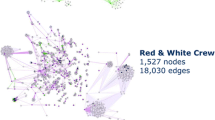Abstract
This article presents a case study of the criminal market activities surrounding the Quebec Hells Angels between 1997 and 2001. The popular and law-enforcement depiction of the Hells Angels, and most notably its Nomad chapter, follows the stereotypical image of traditional organized crime (e.g., monopoly control of the criminal market; a clear hierarchical organization; strict control of the organization’s members and associates). This general claim is tested in this article. The counter argument emphasizes that whereas the Hells Angels organization is a hierarchical structure with clear and explicit rules laid out for its members, there is no clear indication that this formal organziational structure is relevant when studying the criminal activities of members and associates. Quite differently, when it comes to participation in criminal markets, flexibility offers a better fit than the rigid confines of a formal organization. Data for the study was obtained from law-enforcement files that followed an important crackdown on the motorcycle club in Quebec during March 2001—this crackdown and the ensemble of investigations leading up to it have been commonly referred to as Operation Springtime. Through the use of electronic and physical surveilllance transcripts that recorded a high volume of communications between members and associates who were targeted by law-enforcement investigators over a five-year period, a representation of the criminal network surrounding the Hells Angels in their criminal market activities was constructed and analyzed. The main objective of the analyses was to assess the extent to which the Hells Angels hierarchy fits the criminal market activities that were targeted. The working hypotheses guiding these analyses follow that if Nomad members were indeed domineering criminal market participants, we would expect them to be relatively high in degree centrality (hands-on participants) and/or high in betweenness centrality (strategic brokers). Findings indicate that while the Nomads were, on average, higher in brokerage capital when compared with other members within the organization, Nomads were not the most central participants in the overall network. Instead, network participants who were highest in degree centrality were amongst the mid and lower-level members of the Hells Angels organization (suggesting a vulnerable/visible position), while those with the highest brokerage capital participants who held no biker or gang status (suggesting that the strengths of the network lay beyond the formal organization). In sum, the case study highlights the necessary nuances that are needed when approaching organized crime from a scholarly and policy outlook.



Similar content being viewed by others
Notes
A previous version of this paper was published by Springer Science+Business Media in Inside Criminal Networks by Carlo Morselli, ISBN: 978-0-387-09525-7, ©2009. Pg. 32-33, 123-138.
For further details on case selection, data access, and the limits of using law-enforcement data for social network analysis, see Chapter 2 in Morselli (2009).
All analyses were conducted with Ucinet 6 (Borgatti et al. 2002).
The results in Table 1 must be considered in the structural make-up of the overall network, which, according to the network centralization results, were relatively low for all centrality measures. Thus, the analysis involves a search for central participants in a network that was not heavily centralized to begin with.
References
Alain, Marc (2003). “Les bandes de motards au Québec: la distinction entre crime organisé et criminels organisés”, Pp. 135-160 in M. Leblanc, M. Ouimet, and D. Szabo (eds.) Traité de criminologie empirique, 3rd Edition. Presses de l’Université de Montréal: Montreal
Barger R (2000) Hell’s Angel. Harper Collins, New York
Borgatti SP, Everett MG, Freeman LC (2002) Ucinet 6 for Windows. Analytic Technologies, Harvard
Commission de police de Québec (1980). Rapport d’enquête sur les activités des groupes de motards de Havre-Saint-Pierre, Sept-Iles, Mont-Joli, Saint-Gédéon, Sherbrooke et Asbestos. Enquête sur le crime organisé, Éditeur officiel du Québec
Levitt SD, Venkatesh SA (2000) An Economic Analysis of a Drug-Selling Gang’s Finances. The Quarterly Journal of Economics 115:755–789
Morselli C (2009) Inside Criminal Networks. Springer, New York
Morselli, Carlo, Dave Tanguay and Anne-Marie Labalette (2008). “Criminal Conflicts and Collective Violence: Biker-Related Account Settlements in Quebec, 1994-2001”, Chapter 11 (pp.145-164) in D. Siegel and H. Nelen (eds.) Organized Crime: Culture, Markets, and Policies. New York: Springer.
Naylor RT (2002) Wages of Crime: Black Markets, Illegal Finance, and the Underground Economy. Cornell University Press, Ithaca
Naylor RT (1997) Mafias. Myths, and Markets: On the Theory and Practice of Organized Crime, Transnational Organized Crime 3:1–45
Sher J, Marsden W (2004) The Road to Hell: How the Bikers are Conquering Canada. Vintage Canada, Toronto
Tremblay P, Laisne S, Cordeau G, MacLean B, Shewshuck A (1989) Carrières criminelles collectives: évolution d’une population délinquante (les groupes motards). Criminologie 22:65–94
Wasserman S, Faust K (1994) Social Network Analysis: Methods and Applications. Cambridge University Press, Cambridge
Wolf DR (1991) The Rebels: A Brotherhood of Outlaw Bikers. Toronto, University of Toronto Press
Author information
Authors and Affiliations
Corresponding author
Rights and permissions
About this article
Cite this article
Morselli, C. Hells Angels in springtime. Trends Organ Crim 12, 145–158 (2009). https://doi.org/10.1007/s12117-009-9065-1
Received:
Accepted:
Published:
Issue Date:
DOI: https://doi.org/10.1007/s12117-009-9065-1




